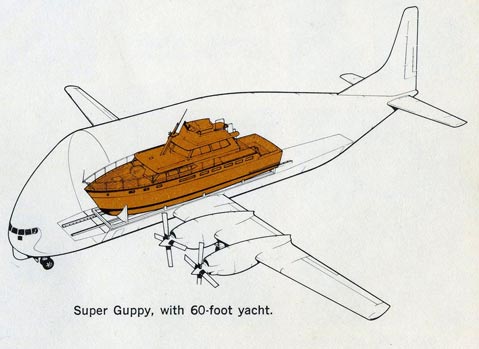The Guppy
S.B. Airport Home to One of the Largest Airplanes in the World

Experts in the field of aeronautics said it would never get off the ground. Jack Conroy refused to listen to the doubters. So it was in the mid 1960s that Santa Barbara Airport became home to the Guppy, one of the largest airplanes in the world, a marvel of aeronautical engineering.
John “Jack” M. Conroy originally was going to be an actor. A native of Buffalo, New York, he eventually made his way to California, where he trained at the Pasadena Playhouse. He appeared in a number of movies as a member of The Tough Little Guys, a group that was supposed to rival the popular Dead End Kids.
Conroy caught the flying bug in 1940, when he earned his pilot’s license while in Hawai‘i, and he then served in the Army Air Corps during World War II. In 1955, he set a speed record for flying from one coast to the other in an Air Force jet. He then worked for a number of commercial airlines.
By the early 1960s, the U.S. space program was in high gear. As the spacecrafts grew in size and power, with ever-larger engines, a problem developed in transporting their large components from factories to test sites to Cape Canaveral. Many of these components were so cumbersome, yet delicate, that the only practical way to ship them was by ocean-going cargo vessels. For example, to ship a Saturn rocket booster, 40 feet long and 18 feet in diameter, from the factory in Sacramento to Florida through the Panama Canal took 15 days and the booster often arrived damaged. Yet there was no aircraft large enough to handle such a load.
Enter Conroy. In 1961, he and aircraft broker Lee Mansdorf founded Aero Spacelines, Inc., and pitched their idea of a cargo aircraft to NASA. The company had purchased a number of Boeing 337 Stratocruisers. These large, propeller-driven, luxurious airliners had been pushed into obsolescence by the rise of jet airliners. Conroy and his team lengthened the Stratocruiser fuselage, and then built a new larger fuselage around the original one before cutting away the latter. Airfoils of cardboard and modeling putty put in front of an electric fan replaced formal wind tunnel tests in order to save money. Conroy mortgaged his house and took loans out against his car and other belongings to scrape up enough cash to see the project through.
This “Pregnant Guppy” had its first successful test flight in September 1962 and made its first cargo flight for NASA one year later. Conroy immediately set about building an even larger plane. The result was the “Very Pregnant Guppy” or “Super Guppy.” The cargo hold of this amazing plane was more than 110 feet long and over 25 feet high, with a volume of almost 50,000 cubic feet. One observer said the Olympic pole-vault event could easily be held inside the aircraft. The plane could haul jet engines, helicopters, oil drilling equipment, or a 60-foot yacht. Most importantly, it could hold NASA’s Apollo rocket stages.
Conroy was not finished; the smaller Mini-Guppy soon made its appearance. In all, the various Guppy models logged over two million miles for NASA. In 1965, Conroy relocated Aero Spacelines from Van Nuys to Santa Barbara. He flew one Mini-Guppy, “Spirit of Santa Barbara,” to the Paris Air Show in 1967, where it won the prestigious Medal of the City of Paris.
Conroy left Aero Spacelines after it was sold in the fall of 1967 and started up Conroy Aircraft Corporation in Santa Barbara. The firm designed a number of large cargo planes and converted older turbo-prop planes to jet power. The company moved to Camarillo in 1977.
Conroy died in 1979. Ever the eccentric, he had written a script for his own funeral. He specified the kinds of food and drink to be served and the order in which the planes should appear in the fly-over at the service. Los Angeles newsman Clete Roberts, a good friend of Conroy’s, presided. Jack Conroy was a designer to the end.



